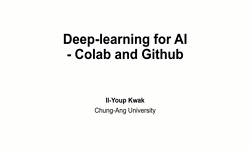






| 1. |  |
Introduction to github, Markdown, Jupyter notebook | Introduction to colab and github |  |
 |
Introduction to github, Markdown, Jupyter notebook | Intro to Markdown |  |
|
 |
Ch1 What is deep learning | Key factors behind deep learning’s rising popularity and future potential |  |
|
| 2. |  |
Ch2 The mathematical building blocks of neural networks (1) | A first example of a neural network |  |
 |
Ch2 The mathematical building blocks of neural networks (2) | Tensors and tensor operations |  |
|
| 3. |  |
Ch2 The mathematical building blocks of neural networks (3) | How neural networks learn via backpropagation and gradient descent |  |
 |
Ch3 Introduction to Keras and TensorFlow | A closer look at TensorFlow, Keras, and their relationship |  |
|
| 4. |  |
Ch4 Getting started with neural networks: Classification and regression | first examples of real-world machine learning workflows - classification and regression examples |  |
| 5. |  |
Ch5 Fundamentals of machine learning | Understanding the tension between generalization and optimization, the fundamental issue in machine learning |  |
 |
Ch6 The universal workflowof machine learning | Steps fframing a machine learning problem, Steps fdeveloping a working model |  |
|
| 6. |  |
Ch7 Working with Keras: A deep dive | Creating Keras models, Using built-in Keras training and evaluation loops, Using Keras callbacks |  |
| 7. |  |
Ch8 Introduction to deep learning for computer vision | Understanding convolutional neural networks, Using data augmentation, Using a pretrained convnet, Fine-tuning a pretrained convnet |  |
| 8. |  |
Ch9 Advanced deep learning for computer vision (1) | The different branches of computer vision, Modern convnet architecture patterns |  |
| 9. |  |
Ch9 Advanced deep learning for computer vision (2) | Techniques for visualizing and interpreting what convnets learn |  |
 |
Ch10 Deep learning for timeseries | Examples of machine learning tasks that involve timeseries data, Understanding recurrent neural networks, Advanced RNN |  |
|
| 10. |  |
Ch11 Deep learning for text (1) | Preprocessing text data for machine learning applications, Bag-of-words approaches and sequence-modeling approaches for text processing |  |
| 11. |  |
Ch11 Deep learning for text (2) | The Transformer architecture, Sequence-to-sequence learning |  |
| 12. |  |
Ch12 Generative deep learning | text generation, deep dream |  |
